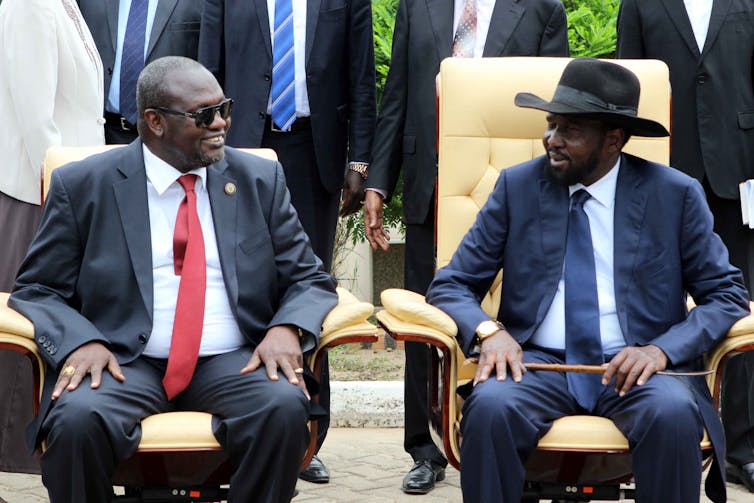
Matthew Hauenstein, University of Notre Dame and Madhav Joshi, University of Notre Dame
The prospect of peace in South Sudan has never been less certain. This is despite the fact that a peace agreement was signed less than year ago. The 2018 settlement revived a failed 2015 agreement between President Salva Kiir and opposition leader Riek Machar.
The 2015 agreement collapsed in less than a year. Two more years of fighting left one-third of the pre-war population forcibly displaced and more than half food insecure.
Now the most recent agreement is facing implementation challenges. In three months Machar is scheduled to rejoin the government. But neither side has implemented the agreement’s safeguards, such as merging their armed forces, designed to prevent a return to war. Kiir and Machar have also resisted face-to-face meetings that could jump-start implementation by building trust and demonstrating commitment to the peace process.
The 2018 agreement was designed to solve two critical issues before Machar entered the government: merging government and opposition armed groups and redrawing the country’s internal borders.
In March we noted that the parties were too far behind to finish either before the united government was scheduled to be formed in May. Commissions tasked with redrawing internal borders were not formed on time. Although they had stopped fighting, the parties’ armed forces had not stood down – the first step to creating a unified army and police.
Given this, Kiir and Machar agreed to wait to form the new government until mid-November, in order to complete the military unification and border demarcation. At the time, they rightly pointed out that,
… the unification of necessary forces is the most critical determining factor for the formation of the Reconstituted Transitional Government of National Unity.
Despite recognising the urgency of creating a unified army and settling the border issue, the parties are no closer to completing either than they were when they signed the extension. The entire peace process remains stalled.
In our research, we developed a framework for measuring how well signatories implement the reforms from a peace agreement. By our measure, South Sudan’s agreement is about 31% complete: basically unchanged from before the extension (29%) and well below the average progress of other peace agreements in our data in the same amount of time (41%).
Our research finds that low levels of implementation increase the risk of renewed fighting, limit foreign investment and keep opposition groups outside the agreement, such as the National Salvation Front in South Sudan, from joining the peace process.
Military unification
Military unification remains stuck at the first hurdle. Under the agreement, all armed groups were to be assembled at designated sites where fighters could be either disarmed and demobilised, or integrated into the unified armed forces and police. In July the parties reported that the designated assembly sites still lacked food, shelter and medicine.
Despite this, the Joint Defence Board, which nominally oversees all armed groups, ordered all fighters to report to these sites by the end of the July.
Given the logistical shortfalls, cantonment was not completed. Even if it had been, this progress would still be far short of what was required by the agreement, which calls for the training and the deployment of unified armed forces prior to the formation of the national unity government.
Border problems
The 2018 agreement outlined a process to allow the government and opposition to jointly determine the number and boundaries of the constituent states within South Sudan. These had previously been unilaterally chosen by Kiir, allegedly to the benefit of his ethnic group. Although the parties followed this roadmap, they have not been able to solve the issue.
Under the agreement, an Independent Boundaries Committee, consisting of representatives of the government, opposition and neighbouring states, was to make a binding recommendation on the number of states in South Sudan. However, government and opposition representatives could not reach a consensus.
The committee is supposed to organise a referendum on the issue if it fails to make a recommendation. However, regional stakeholders are instead hoping for a political solution through face-to-face negotiations between Kiir and Machar.
Looking forward
Despite pressure from the United Nations, as well as regional partners, Kiir and Machar have been reluctant to meet in person. Machar currently resides in Sudan, and his deputies are leading the opposition delegation in Juba, South Sudan’s capital. In July, Kiir invited Machar to Juba. Machar accepted, but only under conditions that Kiir’s government dubbed “unrealistic”.
Kiir’s office also appeared to rule out meeting Machar outside Juba, noting that under the 2018 settlement Machar agreed to come to Juba to participate in the peace process and new government. Despite this, the Intergovernmental Authority on Development, which is the regional mediator, seems to have negotiated a tentative meeting, saying that “the meeting will take place soon”.
In most peace processes, rebel leaders remain in the country. In Sierra Leone, the 1996 accord failed when Foday Sankoh, the rebel leader, left the country.
In Mozambique, the peace process stalled in early 1993. In response, President Joaquim Chissano and former rebel leader General Afonso Dhlakama held five days of talks that built the confidence and trust necessary for completing the demobilisation process and holding elections in 1994.
While a possible meeting is good news, getting South Sudan’s peace agreement back on track will require long term cooperation between Kiir and Machar. Two critical pending issues – the armed forces and internal boundaries – are badly off track halfway through the extension and will require additional negotiations to be resolved.
An initial face-to-face meeting can establish trust between Kiir and Machar, and demonstrate to sceptical international partners that both sides remain committed to the peace process.![]()
Matthew Hauenstein, Postdoctoral Research Associate, University of Notre Dame and Madhav Joshi, Research Associate Professor & Associate Director, Peace Accords Matrix (PAM), University of Notre Dame
This article is republished from The Conversation under a Creative Commons license. Read the original article.

